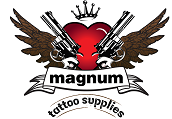Important Tattoo Medical Supplies to Store 0

It's important to keep your tattoo shop stocked with all the tattoo medical supplies needed to prep and modify clients--things like antiseptics, skin cleansers, tattoo bandages, and disinfectants.
Read through the sections below to compare your options within each product category.
Autoclaves & Autoclave Supplies
An autoclave steam steriliser is the single most effective tool for sterilising reusable tattoo supplies like steel grips and tattoo tubes. You'll be able to sterilise larger batches of tools faster and more thoroughly with an autoclave than you could with chemical baths or other sterilisation alternatives.
There are several types of autoclave accessories in store to keep on hand to get the most out of your steam steriliser. Every tool you sterilise will need to be bagged separately before being autoclaved, so it's a good idea to stock up on sterilisation pouches and nylon tubing in a variety of sizes. A heat sealer is also needed to seal your autoclave bags, steam sterilization integrators that clearly show when your tools have been fully sterilised, a reliable autoclave cleaner you can use to clean your steriliser regularly, and spore testing kits so you can periodically test your machine to make sure it's operating optimally.
Cleaners
Tattoo tools have to be thoroughly cleaned before they're autoclaved, and a variety of tools are readily available to simplify the cleaning process.
An autoclave can be a huge time saver for a busy shop. Without an autoclave, you have to hand-scrub all of your reusable tattoo tools, soak them in disinfectant and lubricate them before you sterilise them. If you're interested in shortening the clean-up process in between clients so you can tattoo more people in a day, you need an ultrasonic cleaner.
Tattoo Cleaners, Disinfectants & Bio-Hazard Containers
It's highly critical that you maintain a sterile work environment to keep your clients safe and make them feel secure when they get tattooed in your shop. To keep surfaces sterilised throughout your shop, you'll need an assortment of disinfecting cleaning products. You should also make biohazard containers easily accessible to your tattoo artists so that they can properly dispose of used tattoo needles, other sharps, and contaminated protective gear, like used tattoo machine bags.
Tattoo Covers & Protective Gear
In your efforts to maintain a sterile work environment within your tattoo shop, you should bag all reusable tattoo tools that can't be autoclaved, like tattoo machines and clip cords. Additionally, it's important that your tattoo artists wear medical gloves while tattooing, and that they change them at appropriate intervals. Some artists also like to cover more of themselves, for their health, to prevent cross-contamination and to protect their clothing.
For tattoo gloves, choose from latex and nitrile gloves in a variety of sizes and styles from brands like Defend, Aurelia, Black Dragon, Midknight, Ultraform, and more.
When you're tattooing a client's face or neck, it's best to wear a face mask. These surgical face masks come in boxes of 50 and have ear loops to hold them in place.
Antiseptics, Skin Cleansers & Other Skin Prep Products
Before tattooing a client and after applying any topical anaesthetic requested, you have to perform surgical skin prep. This process requires washing the skin with an appropriate skin cleanser, and then applying a CDC-approved antiseptic. Make sure your client isn't allergic to any of the skin prep products you're planning to use. Some people have iodine allergies while others have sensitivities to fragranced soaps, so it's important to talk to your clients about the tattooing process and products you use before you begin
Top brands like Intenze, Green Soap, Tattoo One, Tattoo Goo, and H2Ocean are just some of the well- known skin cleaners that are being used by tattoo artists, as well as surgical-grade antiseptics like alcohol pads and providone iodine swabs.
- Matthew Nelson
- Tags: Magnum Tattoo Supplies blog MTS blog tattoo anaesthetics tattoo blog tattoo machine tattoo tips UK
Tattoo Styles Guide for Newbies 0
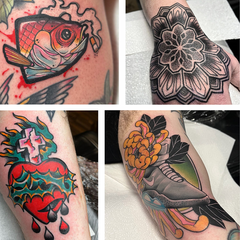
Tattooing has been around for centuries, and it's only natural that tattoo styles have evolved over time. From traditional style tattoos to modern variations like the geometric tattoo style, the possibilities are virtually endless.
Read more about different tattoo styles today
- Matthew Nelson
- Tags: tattoo tattoo artist tattoo artists tattoo blog tattoo enthusiasts tattoo ink tattoo shop tattoo skill tattoo styles tattoo tips UK
Tattoo and its beginnings 0

Having a tattoo in any part of your body seems to be a lot more acceptable in the society today than before. People used to think that tattoos are only seen in the bodies of criminals and the likes. But now, it has even become an accessory to some people.
By using needles and ink, a tattoo is a kind of art that is engraved in the skin permanently. The word tattoo comes from the Tahitian word “tatua”. This means “to mark.” Despite the fact that tattooing have been practised for hundreds of years by people of various cultures, it has gained social acceptance everywhere just recently.
Tattooing eye-catching illustrations to the skin has been a widely known practice since the ancient times. Throughout the centuries, various types of tattoo art have been put into practice by a lot of diverse world cultures. One example is of the Japanese culture. Around 500 B.C., they started using tattoos for cosmetic and religious purposes. They even used it as a punishment for criminals by branding them. This method by the Japanese involved piercing the skin of the individual with fine metal needles in order to craft designs with different colors. In addition, the Eskimo tribes also established their own technique by using bone needles in order to draw the soot-covered thread through the skin.
Over the last 200 years, the art of tattooing kept on growing. In the nineteenth century, this said fame caught the attention of the upper class men of England. One example is Lady Randolph Churchill, mother of Winston Churchill, who had a snake tattoo on her wrist. In the United States, tattoos have been linked to prison inmates, sailors, and motorcyclists because before, tattoo shops were thought to be dangerous and socially unacceptable. But this type of perception has greatly changed since the 1980s. Tattoos are already becoming popular to men and women of all ages all over the world.
“Flash” is what you call a tattoo design. It can be made up of any type of artwork ranging from the simplest symbols or letters to thorough sketches and cartoons. Flash can be composed with different colors. Tattoo parlours show a large variety of flash on their walls with the larger ones having approximately 10,000 to choose from. Also, clients may carry with them their own preferable design or they can work with the tattoo artist to develop custom flash.
Always bear in mind that whenever you choose a tattoo design you must consult with the artist to know a suitable size and placement for the tattoo. The artist can also give you aid in deciding which color schemes to use that will determine the price of the final art. Caring for your tattoo is a must and that is why there is a need to conduct a research whether your tattoo parlour follows the guidelines that were set by the Association of Professional Tattooists (APT).
- Matthew Nelson
- Tags: MTS blog tattoo tattoo artist tattoo blog tattoo ink tattoo machine
Basic Tattoo Materials and Equipment 0
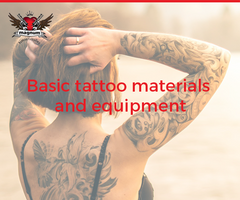
- Flash
The tattoo design or commonly called as “flash” is simply a sketch or a piece of line art that is used to make a tattoo. It can be black, white, or any colour. They are mounted on the walls or displayed in books in the tattoo parlour.
- Stencil
A stencil is just a copy of flash however it is crafted on a special copying paper. The stencil permits the inked outline of the design of the tattoo to be transferred to the client’s skin in order for it to be marked out by the artist.
- Ink
Special inks that are used in order to produce great tattoos are sold by tattoo supply shops. They are usually available in a different kinds of colours and are typically packaged in 4 oz plastic squeeze bottles so they are easily handed out. These inks are liquid dispersions of pigments. They are permitted by the Food and Drug Administration in the United States. The ink is composed of dyes that come from metal components. Due to this reason, allergic reaction to the type of ink used is more likely.
- Tattoo Machine
The tattoo machine is composed of a hand held needle gun attached to a power unit that makes it possible for the pressure to move the needles. The needles can come in different sizes and shapes and are packed jointly on a needle bar in various types of patterns depending on the needs of the artwork. The unit is connected to a power supply that is started by depressing a foot pedal on the floor bedside of the work station. When the pedal is depressed the tattoo needle bar moves up and down quickly. Imagine that of a sewing machine. It makes a way into the skin to inject the dye 3000 times per minute.
- Miscellaneous Supplies
For the whole tattoo procedure the artist may use supplementary supplies like skin disinfectants, petroleum jelly, bandages, razors, and biocidal cleaning supplies.
- Tattoo Removal
Sometimes people with tattoos come to a point in their lives where they decide to have their tattoo removed. Tattoo removal is now possible, thanks to advance technology, however the process is not easy, costly, and sometimes not fully successful. Not so long before, a wire brush was used to rub the skin and wipe out the first and second layers where the ink is present. In order to leach out the ink, salt solutions and acid were used to burn the skin away.
All of these methods are costly, painful, and not very effective. Even though the tattoo can be removed, the affected area may lose its capability to produce normal skin pigment and some scarring will be unavoidable. Today, lasers have been developed to remove tattoos, as it can tear down most of the ink pigment with very little scarring.
Places Where Tattoos Hurt Most 0
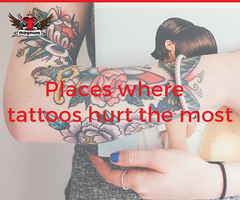
Rule of thumb is, the thinner the skin, the more it hurts. Having said that, pain is temporary, but tattoos are forever.
Before getting a tattoo, you should have already accepted the fact that the process will hurt, especially if it is your first time. This might be one of the reasons why people don’t get a tattoo. But don’t let that fear hinder you from expressing yourself with body art. Once you set your mind to it and prepare for the tattooing process you'll find that your body has the ability to withstand the pain under most circumstances. It is really important to be extra sure of your decision, you have to make sure that it is really what you want.
Being informed is important. Below are five spots where placing a tattoo hurts the most.
Behind the Ear
Knowing the area around the ear having thin and delicate skin is an obvious cause that this tattoo placement is going to hurt a lot more. This area is very sensitive since it does not have much fat. However, don't let that stop you from inking an easy to conceal design. Whether it be a single phrase or an insect tattoo, your tattoo artist can help numb the anticipated pain with a specialised cream. It may be of minimal help, but hey, at least it helps.
Chest
Chest tattoos are a popular choice for both men and women. Either way, most chest piece tattoos are going to be painful unless you have lots of body fat or muscle. If you're skinny or of small frame, be prepared to endure a little more for your Old School swallow tattoo.
Ribs
Getting tattooed on the rib cage is considered one of the most painful spots to get inked. Due to each person’s unique size, shape and natural curves, rib cage tattoos can also be more challenging for tattoo artists. However, the rib cage offers a beautiful spread of canvass. The thin skin, however, across the ribs can cause quite a bit of a challenge for those being tattooed. You may find starting small and then gradually adding to a side rib cage design is the best way to test the waters first.
Ankle
When you get a tattoo made on your ankle, you can feel the reverberations and the friction of the needle throughout your feet. It won’t feel like tickling, it is pain; real pain. Even a small tattoo could hurt so much, since there is nothing but bone in your ankle. Delicate as they may seem, ankles pull their weight as one of the hurtful spots to ink regardless of their size.
Foot
A lot may testify that getting a foot tattoo is the least option a tattoo artist may give you since it gives uneven and poor healing results, not to mention the pain that comes with this placement. The feet and toes are all about bones. When you are getting a tattoo done on your feet, the needle will hit the bones and it will most definitely hurt a lot. The foot has a small distribution of body fat so you'll feel much more of the process. But that doesn't mean a dragon character or a minimal feather won't always look gorgeous, so have at it if you must.
- Matthew Nelson
- Tags: blog foot tattoo health people with tattoo tattoo blog tattoo enthusiasts tattoo healing tattoo ink tattoo tips
Starting a Tattoo Shop: Where should you begin? 0
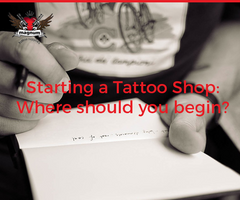
For many years, tattoo arts remain a trendy fashion statement around the globe. It just never goes out of style. Many people are acquiring tattoos and the tattoo industry is steadily on the rise. By doing some researches here and there, opening a tattoo parlour can be a bearable job. Here are some steps to follow in creating a tattoo shop of your own.
Preparation
- Familiarise yourself with the business and acquire proper training. Being a tattoo artist is not really necessary for you to open a tattoo shop. But, a wide understanding about the business is very crucial. If you are a novice tattooist, complete an apprenticeship to ensure that you are properly trained. As a non-practicing shop owner, complete a significant amount of comprehensive research regarding the profession or partner up with an experienced tattooist.
- Go to the nearest local health, city, or municipal department and find out about tattoo business regulations in your area. You should know the laws relating to tattooing and sanitation, although it may vary depending on your location. Your local governing divisions can also direct you to the proper agencies to obtain more information about applying for any required permits and licenses.
- Create a start- up business plan and explore tattoo business software. Your business plan is an important tool and serves as a vision for outlining how much capital is needed to start your tattoo shop, as well as calculating future projections and profit. There are a lot of programs and applications that you can download from the internet to help you create a business plan or you can get assistance from a professional accountant.
- Choose a location that has high traffic. Depending on the type of building you choose, you may have to make some improvements or alterations to accommodate your artists and properly equip the facilities, such as plumbing or electrical outlets.
- Establish an advertising campaign promoting your shop. A strategic marketing is very much needed, especially if you are a beginner, to ensure steady flow of clients. Advertisements such as flyers, social media, TV and radio ads, or even an old-fashioned word of mouth, are great examples of marketing. Plan all of this at least 30 days before opening your shop.
Opening the Tattoo Shop
- Finish and decorate certain areas of the shop. Purchase and install necessary furnishings to accommodate your artists and clients. Work areas need reclining chairs, just like a dentist’s. Lighted tracing tables, supply carts, and large mirrors are also needed. Reception areas, on the other hand, need a counter or desk, chairs, couches, and shelves for display.
- Purchase all required equipment and supplies. Before opening the shop, make sure you are well stocked with all the supplies, materials and equipment needed to properly and efficiently function. Tattooing equipment and supplies typically include an autoclave for sanitising instruments, tattooing machines, needles, ink, paper towels, plastic spray bottles and plastic or latex gloves. Office equipment might include a computer, adding machine, telephones and printers.
- Lastly, hire professional artists to sufficiently staff your studio. The number of artists needed depends on how big your shop is and how much clientele you expect to generate. Prior to opening the shop, evaluate your target clients, prepare hiring staff, and enough professionally trained tattoo artists.
- Matthew Nelson
- Tags: Magnum Tattoo Supplies MTS blog tattoo tattoo artist tattoo artists tattoo blog tattoo shop tattoo tools UK
